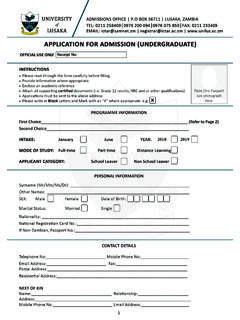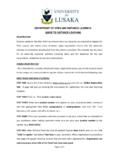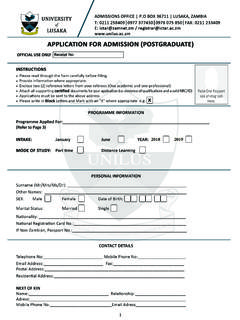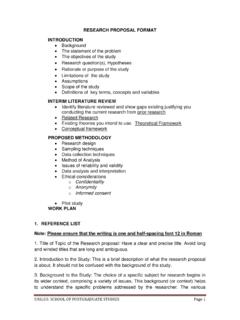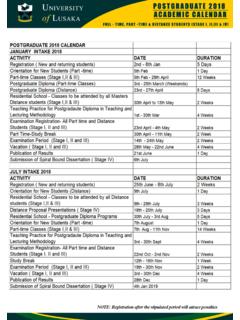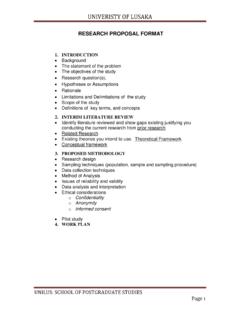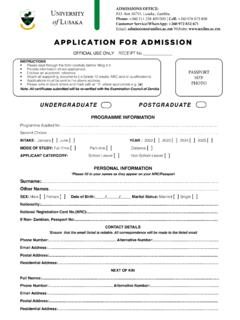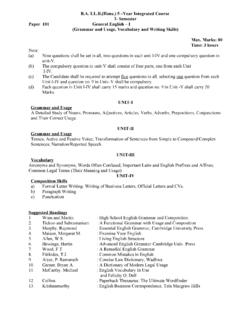Transcription of LECTURE NOTES - University of Lusaka
1 THE COPPERBELT University . SCHOOL OF BUSINESS. BACHELOR DEGREES IN BUSINESS ADMINISTRATION, MARKETING AND BANKING AND FINANCE- CBU & UNILUS. BS/BF 450/BSP 466: STRATEGIC MANAGEMENT. LECTURE NOTES . LECTURER: DR. B. MALITI. 2012. Course Objectives This course should prepare students on how to: a) Evaluate the environment in which they are operating. b) Prepare strategic plans. c) Develop and analyse strategic alternatives d) Implement the strategic plans and decisions Course Syllabus 1. Introduction to the discipline of strategic management. - Evolution of strategic management - Major elements of strategic management - Strategic leadership and decision-making. - The characteristics of successful organisations 2. The process and practice of strategic management - Levels of strategic management - The strategic management process. - Elements of the strategic management. - Organisational planning process 3. Analysing the general environment.
2 - The importance of environmental influences - An analysis of the total business environment, the nature and consequences of industrial and the technological changes. - The economy - Technology - Social factors. - Political and legal considerations - The effect of market and industry structure. - The product and market life circle. 4. Developing and strategic options. - Strategic decision making. - Creating sustainable advantages. 2. - Evaluating the strategic situations. - Developing and evaluating strategic alternatives 5. Developing the strategic plan - Strategic decision support system. - Strategic planning systems. - Planning under risk and uncertainty - Putting it all together 6. Strategic implementation and control - Implementing strategic planning process - Implementing strategic decisions - Implementing strategic plans - Strategy and structure relationships - Social and political influence - Strategic control Course Assessment The course grading shall have the following two components: 1.
3 Continuous Assessment (40 %). a. Assignments (3) 15 %. b. Term Tests (3} - 25 %. 2. Sessional Examination (60 %). 3. TABLE OF CONTENTS. PAGE. 1. Introduction to the discipline of strategic management. - Evolution of strategic management - Major elements of strategic management - Strategic leadership and decision-making. - The characteristics of successful organisations - The Case Study method 2. The process and practice of strategic management - Levels of strategic management - The strategic management process. - Elements of the strategic management. - Organisational planning process 3. Analysing the general environment. - The importance of environmental influences - An analysis of the total business environment, the nature and consequences of industrial and the technological changes. - The economy - Technology - Social factors. - Political and legal considerations - The effect of market and industry structure. - The product and market life circle.)
4 4. Developing and strategic options. - Strategic decision making. - Creating sustainable advantages. - Evaluating the strategic situations. - Developing and evaluating strategic alternatives 5. Developing the strategic plan - Strategic decision support system. - Strategic planning systems. 4. - Planning under risk and uncertainty - Putting it all together 6. Strategic implementation and control - Implementing strategic planning process - Implementing strategic decisions - Implementing strategic plans - Strategy and structure relationships - Social and political influence - Strategic control References .. 1. Arthur Thompson, Strategic Management , McGraw-Hill Education, 2002. 2. Ralph D. Stacey, Strategic Management and Organisational Dynamics: The Challenge of Complexity , FT Prentice Hall, 2002. 3. Thompson, Strickland, Readings in Strategic Management , McGraw-Hill Education (ISE Editions), 2000. 4. David Hussey, Strategic Management: From Today to Implementation , Butterworth-Heinemann, 1998.
5 5. Robert Burgelman, Modesto A. Maidique, Strategic Management of Technology and Innovation , McGraw-Hill Education (ISE Editions), 2003. 6. Peter L. Wright, Strategic Management: Concepts and Cases (International Edition) , US Imports & PHIPEs, 2002. 7. Pearce, Strategic Management , McGraw-Hill Education, 2002. 8. Paul Finlay, Art and Science of Strategic Management , FT Prentice Hall, 2000. 9. Michael A. Hitt, et al, The Blackwell Handbook of Strategic Management (Blackwell Handbooks in Management) , Blackwell Publishers, 2001. 10. Hugh Macmillan, Mahen Tampoe, Strategic Management: Process, Content and Implementation , Oxford University Press, 2000. 11. Wendy Robson, Strategic Management and Information Systems: An Integrated Approach , FT Prentice Hall, 1997. 12. Michael J. Stahl, Cases in Strategic Management: Instructor's Manual , Blackwell Publishers, 1999. 13. Jon Sutherland, Diane Canwell, Key Concepts in Strategic Management (Palgrave Key Concepts), Palgrave Macmillan, 2004.
6 14. Colin White, Strategic Management , Palgrave Macmillan, 2004. 5. CHAPTER 1. STRATEGIC MANAGEMENT. 1 Introduction to the Discipline of Strategic Management. Evolution of Strategic Management Strategic management is that set of managerial decisions and actions that determines the long-run performance of a corporation. The study of strategic management, therefore, emphasizes the monitoring an evaluating of external opportunities and threats in light of a corporation's strengths and weaknesses. Originally called business policy, strategic management incorporates such topics as long- range planning and strategy. Business policy, in contrast, has a general management orientation and tends primarily to look inward with its concern for properly integrating the corporation's many functional activities. Strategic management, as a field of study, incorporates the integrative concerns of business policy with a heavier environmental and strategic emphasis.
7 Therefore, strategic management has tended to replace business policy as the preferred name of the field. The Historical Context of Strategy Until the late 19th century, organizations that were not owned by the nation state were too small to be considered as corporations. Small artisan factories driven by crafts may have needed strategies to survive and prosper against competitors, but formal strategic management did not exist. North America, Europe and Japan were more or less the only areas that had begun to industrialise by the end of the 20th century. Countries such as China, India, Korea, Malaysia, Singapore, Nigeria, South Africa, the Phillipines, Saudi Arabia, Iran and Iraq were still largely without industry; they supplied commodities and raw materials to world markets but had not yet begun to industrialize. Strategic management, which is principally associated with increased industrialization, was therefore more likely to develop in the industrialized countries than in other areas around the world.
8 Strategic Management in the Early 20th Century 6. During the early 20th century, particularly in the USA and Europe, managers rather than academics began to explore and define the management task. Taylor in the USA and H. Fayol in France are examples of senior industry figures who started to research and write on such issues. They were industrialists rather than academics, holding senior positions in industry for some years. Around the same time, Henry Ford began experimenting to produce goods more cheaply and fulfill growing market demand. In the period 1908 1915, he developed strategies that we still recognize today, and included those outlined below: Early Strategies Still Recognized Today From the period 1908- 1915: Henry Ford Innovative technology Replacement of men by machines Search for new quality standards Constant cost-cutting through factory redesign Passing on the cost reductions in the form of reduced prices for the model T car From the period 1920 1935: Alfred Sloan and colleagues Car models tailored for specific market niches Rapid model changes Structured management teams and reporting structures Separation of day-to-day management from the task of devising longer-term strategy Henry Ford did not believe in major model variations and market segmentation, unlike his great rival from the 1920s, General Motors headed by Alfred Sloan.
9 Nor did Ford believe in the importance of middle and senior management. He actually sacked many of his senior managers and ultimately left his company in real difficulties when he died. Hence, his rival in the 1920s and beyond, General Motors, was ultimately more successful with other strategies that still exist today. After the First World War came the great economic depression of the 1930s. This brought the need for a new order in international currency and, just as importantly, the desire for larger companies to gain economies of scale. However, much of this was confined to North America and competitive strategy itself was still in its infancy. Strategic Management in the mid-20th Century The Second World War brought its specialist demands for military equipment, coupled with more destruction across much of Europe and Japan; North and South America went 7. largely unscathed. At this time, the Middle East and Far East still remained largely outside the scope of industrial development.
10 This period was hardly the time for strategic managers to influence events. Yet strategic game theory had its origins in developing more effective British naval tactics when hunting for German U-boats. The late 1940s probably witnessed the period of the greatest power of North American industry and companies. It was also the real beginning of strategic management development and this then continued into the 1950s. It was accompanied by the reconstruction of industry across Europe and the beginnings of the Asian development period, particularly in Japan. Economists like Penrose were beginning to explore how firms grew, and human behaviourists like Cyert and March suggested that rational economic behaviour was an oversimplified way of considering company development. By the late 1950s, writers such as Ansoff were beginning to develop strategic management concepts that would continue into the 1970s. During the 1960s the early concepts of what would later become one of the main approaches to strategic management prescriptive strategic management began to take shape.
